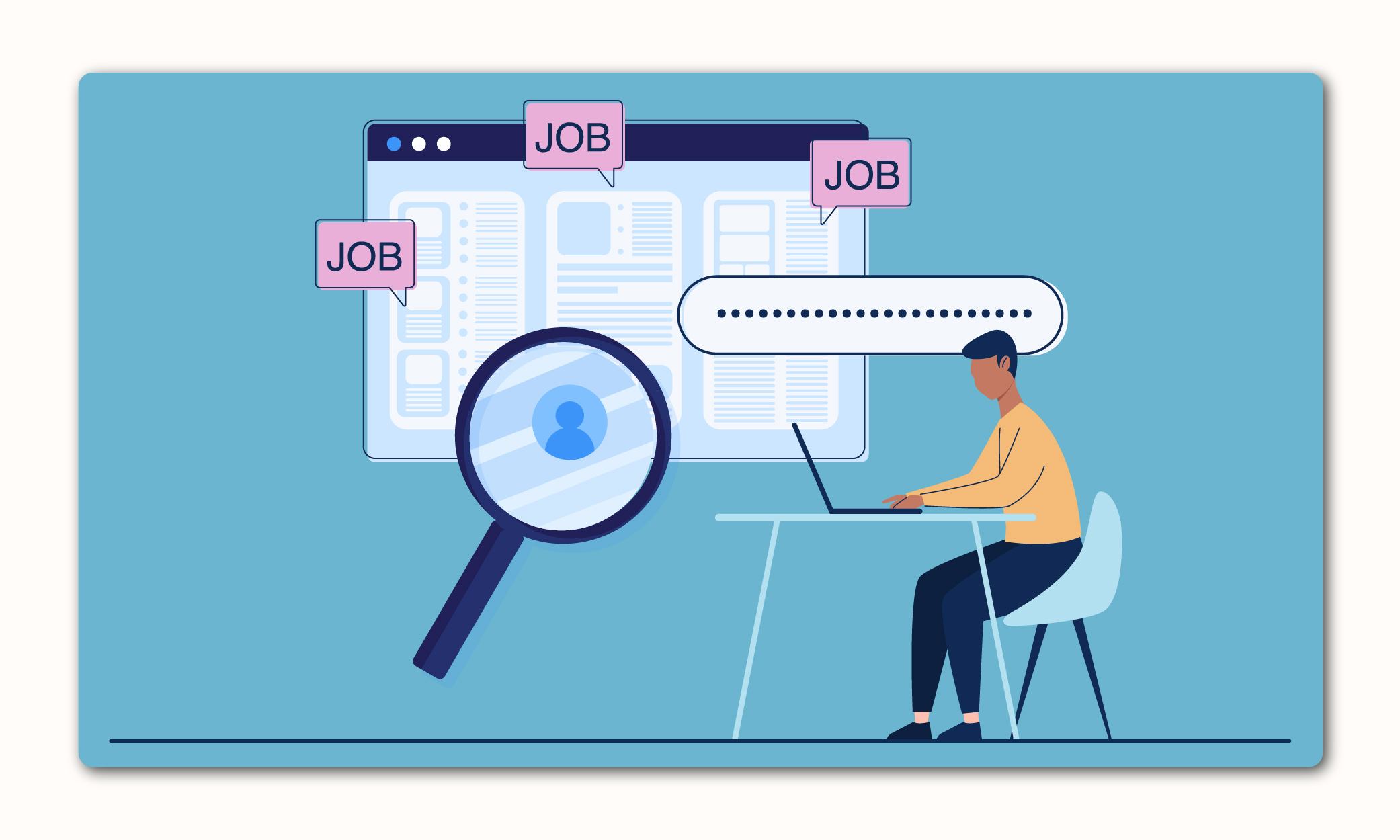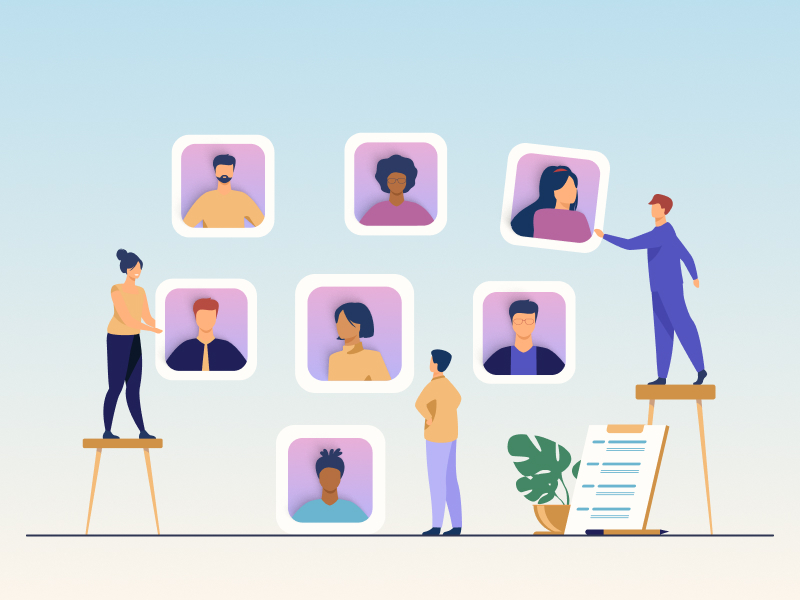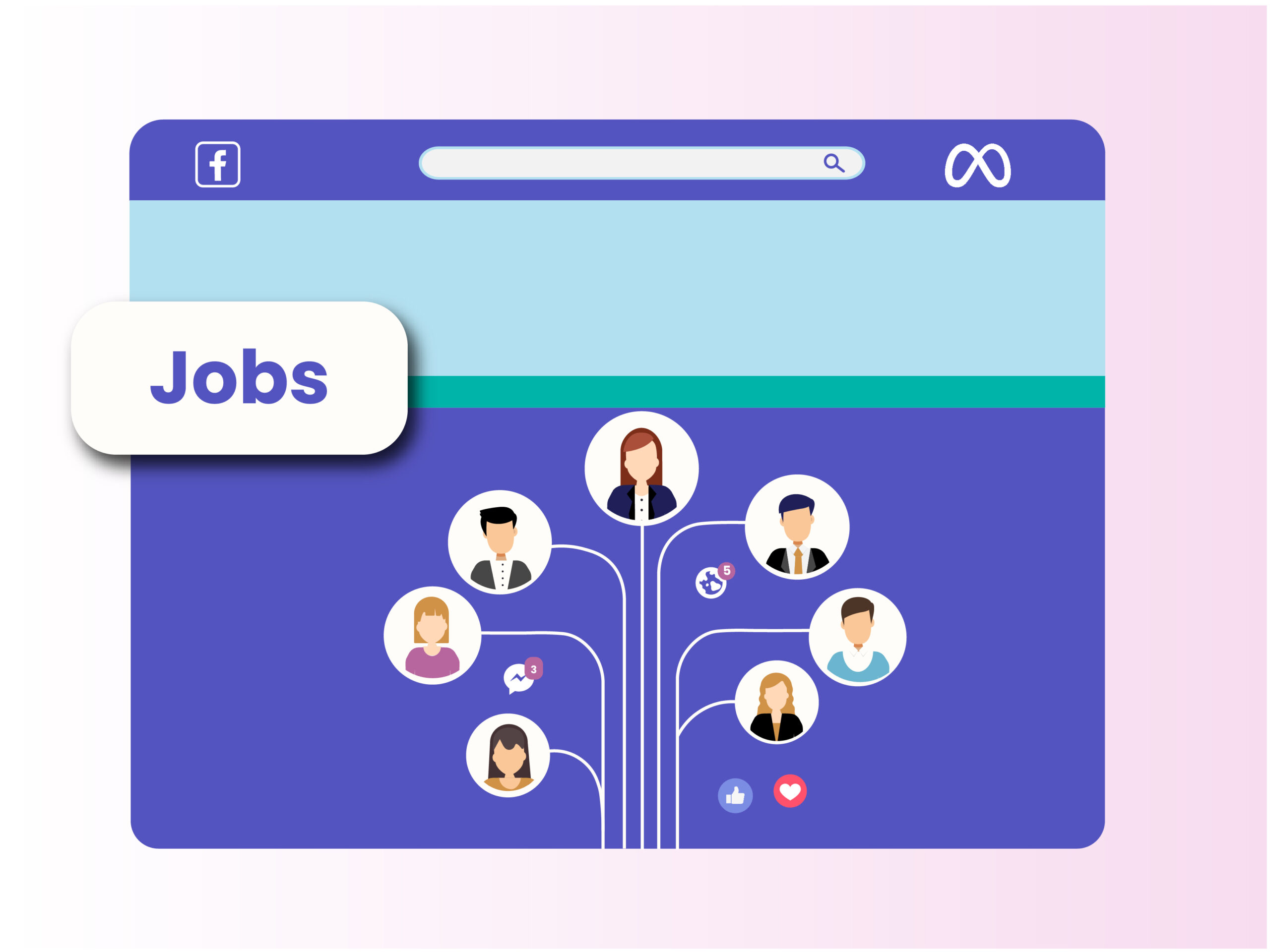Introduction
Businesses have never done as much hiring as they do today, and they’ve never spent as much money doing it.
But, the big question… is it efficient?
We’ve got smarter technology, Web 2.0, and emerging skills and jobs, but for some reason career sites are virtually unchanged from the early days of the internet. They’re built to invite prospective candidates to come and view jobs that interest them and then apply. Period.
Boring!
Okay, okay. Granted, there have been changes in the way companies approach career sites – storytelling elements and a content-first mindset have emerged based on marketing best practices. But, as we move into Web 3.0, it’s time to think long and hard – is a career site just another tactical tool to expand the hiring funnel? Or is it a pillar of a larger talent acquisition strategy?
What is a Career Site?
A career site, also called a career page, is a section of an employer’s website that features job openings and other employment-related information. Career sites typically follow the landing page design, where candidates can browse open jobs and learn more about hiring criteria, skill requirements, and existing employees. In a way, the career site is an employer’s pitch to convert interested candidates into applicants.
Over the past two decades, some career sites have gone from static to dynamic, expanding their content and allowing prospective applicants to interact with the site in multiple ways – apply for a job, read about the org’s mission and culture, or view a video testimonial by an existing employee. But they’re still far more transactional than other consumer websites. Think about it – it’s much easier to buy a car online than to apply for a job on a career site. The amount of info required for most job apps is staggering!
Why is a Career Site an Ideal Recruiting Solution?
Recruiting in today’s competitive job market presents several challenges: attracting the right candidates, showcasing company culture effectively, and ensuring a seamless application process. A top-notch career site can help address these hurdles for recruiting success.
First off, your career site is the perfect stage to highlight your awesome company culture and benefits. It’s where you get to brag why working at your organization is the best gig in town. Think of it as your chance to make a stellar first impression and reel in top talent with all the perks and vibes that make your workplace unique.
Next, let’s talk about making the journey a bit easier for candidates – like a smooth, intuitive application process. A well-designed career site puts your job listings front and center, works seamlessly on mobile devices, and syncs up with your applicant tracking system (ATS). This not only makes the experience a breeze for job seekers but also helps cut down on drop-off rates and boosts your hiring success.
Finally, a career site can be a magnet for the right candidates. By featuring tailored content and strategic messaging, you can connect with niche talent pools, especially those in competitive industries with hard-to-fill jobs. This targeted approach ensures you attract qualified candidates who are a perfect fit for your company.
All in all, a stellar career site can be your secret weapon for tackling recruiting challenges and hitting your hiring goals out of the park.
What Do Candidates Look for in a Career Site?
When candidates land on your site, they’re on a mission. They want to know if your company has any open roles for them and if you’re the right fit. They’re scanning for specific elements that will help them decide. So, what exactly are they looking for? Let’s break it down.
- Clear job listings: Job seekers want to find openings quickly and easily. Therefore, your job listings should be clear, detailed, and well-organized. Offer filters and search functions to help candidates zero in on the positions that match their skills and interests.
- Employee-generated content: Nothing sells your company better than authentic stories from people who work there. Encourage your employees to share their experiences through blog posts, video testimonials, or social media. This gives candidates a genuine look at your company culture.
- Employer branding: Your career site is the perfect place to showcase what makes your company unique. Highlight your mission, values, and the benefits you offer. Use your employer brand to tell a compelling story that resonates with potential hires.
- Engaging visuals and videos: As they say, a picture is worth a thousand words, and a video in today’s age is worth even more. Use high-quality visuals and engaging videos to give candidates a feel for your workplace. Show your office, team events, and any perks that make your company a great workplace.
- Social integration: Make it easy for candidates to connect with you on social media. Include links to your company’s social profiles and display a live feed of your latest updates, if possible.
- Talent community: Not every visitor to your career site is ready to apply right away. Create a talent community where potential candidates can sign up to receive updates about relevant (that’s the key word here!) new job openings, company news, and events. This keeps them in the loop and helps you build a pool of interested candidates.
By incorporating these elements, your career site will attract top candidates, keeping them engaged and excited about the possibility of joining your team.
How Your Career Site Can Transform Your Talent Acquisition
How Your Career Site Can Help Build a Powerful Employer Brand
- Highlight your company’s culture, values, and work environment.
- Use employee testimonials and behind-the-scenes videos to create a compelling narrative.
- Emphasize unique benefits and perks that set your company apart.
- Reinforce your commitment to transparency and inclusivity to solidify your employer brand.
Enhancing Candidate Experience: The Role of Your Career Site
- Ensure your site is intuitive and easy to navigate, with clear job listings and straightforward applications.
- Optimize your career site for all devices to provide a smooth experience.
- Use high-quality images and videos to offer a virtual tour of your workplace.
- Include testimonials from current employees to add a personal touch and authenticity.
- Provide a seamless experience from application to onboarding.
Career Site: Your Weapon for Talent Attraction
- Craft clear, appealing job descriptions that highlight the role, expectations, and what makes your company a great place to work.
- Keep your career site updated with new job postings, company news, and blog posts.
- Regularly refresh content to keep candidates engaged and show that your company is active and thriving.
- Tailor content and messaging to connect with niche talent pools and attract the right candidates.
How to Design and Optimize Your Career Site?
Creating a successful career site involves more than just posting job listings. It’s about crafting an engaging, user-friendly experience that showcases your company’s culture, values, and opportunities. By rethinking how you design and manage your career site, you can turn them into powerful tools for attracting top talent. Let’s explore why many career sites fall short and how we can transform them into dynamic, personalized platforms.
Personalization: Why are Career Sites Still Lagging?
Career sites by themselves are just a collection of web pages and content. For them to be useful, one or more solutions are required – namely, an applicant tracking system (ATS) and candidate relationship management solutions (CRM). Sure, there are CRM and ATS vendors who now provide career sites as an add-on solution, but in most cases, these sites function as bolt-on solutions. They’re limited in their flexibility and can be quite difficult to upgrade, meaning they ain’t so future proof.
There’s also usually a lack of personalization and adaptability. A candidate may subscribe to the careers newsletter and receive regular communication on open roles, but when they click on a provided link, they are asked to fill in all personal details. Again. And this is a big issue with inbound recruiting today. Nurture campaigns, drip campaigns, and content marketing via career sites are all separate activities. The underlying intent might be the same – converting great-fit prospects into applicants – but they are a collection of different workflows, often managed by different people, across multiple tools.
Career Site as Product: Designing Delightful Digital Experiences
Bringing e-commerce thinking into career sites is the next big (r)evolution, creating an evolving software application with a strategy and road map. So, why is this concept so revolutionary?
Making your data work for you
Data should inform all decisions, but let’s focus on how it helps when it comes to building and maintaining a career site. Yes, pageviews, heatmaps, and click-through rates are already being used by many orgs, but they’re more descriptive and don’t really offer insights that help make the experience more memorable for users.
Reimagining your career site as a digital product means thinking of them as living entities that get smarter with every candidate interaction, using AI and machine learning to personalize content and automate marketing strategies. Think of consumer sites like Amazon – every time you log in, their engine provides a list of personalized recommendations based on previous orders or browsing history.
Candidates increasingly expect the same sophisticated digital experiences when applying for jobs.
Adapting and evolving
Many organizations still view career pages as a one-time activity – set it up and it will fill that hiring funnel for as long as it’s updated with open positions (and possibly content). Factors like UI/UX, language, accessibility, and forms often remain unchanged. As a result, these sites mushroom over time and multiple thread code bases become hard to work with due to size and complexity.
Instead, imagining career sites as a product ideally means a serverless model that can provide scale and flexibility on demand. It would also rely on automated SEO, remarketing ad tech, social sharing, and stellar content that drives engagement.
Search engine optimization (SEO)
When candidates search for job opportunities online, they typically start with a search engine like Google. By optimizing your career site for SEO, you can ensure that your job listings and career-related content appear prominently in search results. This increased visibility can attract more qualified candidates, ultimately expanding your talent pool and giving your company a competitive edge.
In short, effective SEO involves incorporating relevant keywords, creating high-quality content, and ensuring a user-friendly experience. Plus, providing valuable content, such as blog posts, industry insights, and company news, can improve your site’s ranking and attract more visitors.
More on that here.
A thriving ecosystem
Career sites need to be thought of as ecosystems in their own right, instead of a project with a start and end date. This means multiple tools, data sources, and strategies working together toward a common goal. For instance, behavioral data from a programmatic platform flows seamlessly into the ATS and career site – offering valuable insights into candidate preferences. This data can be used to create personalized communication based on attributes such as job location, role, and work experience. All of these solutions will function as independent micro-services, working seamlessly to create a unified candidate experience.
The key here will be the speed and agility with which vendors can respond, update, or iterate to serve changing marketplaces, candidate needs, and client requirements.
Chunk content saves time
Recruitment marketers want to provide the most usable – and reusable – content possible, saving time, while increasing the value candidates get from your career site.
Creating content in chunks or thinking of them as components and modules based on the types of information you want to convey, is an efficient fix. A “chunk” is a discrete unit of content. It can be as small as a bullet point or as big as a book. It could be a paragraph, a section, a chart, a table, or an entire asset. In the career site context, a job description is a content chunk even as it may be a part of a bigger chunk (a blog post, say) and even as it contains chunks (skills required) that you could lift out and reuse, out of context.
Here’s a quick look at how career sites as a product differ from their current state – a collection of web pages.
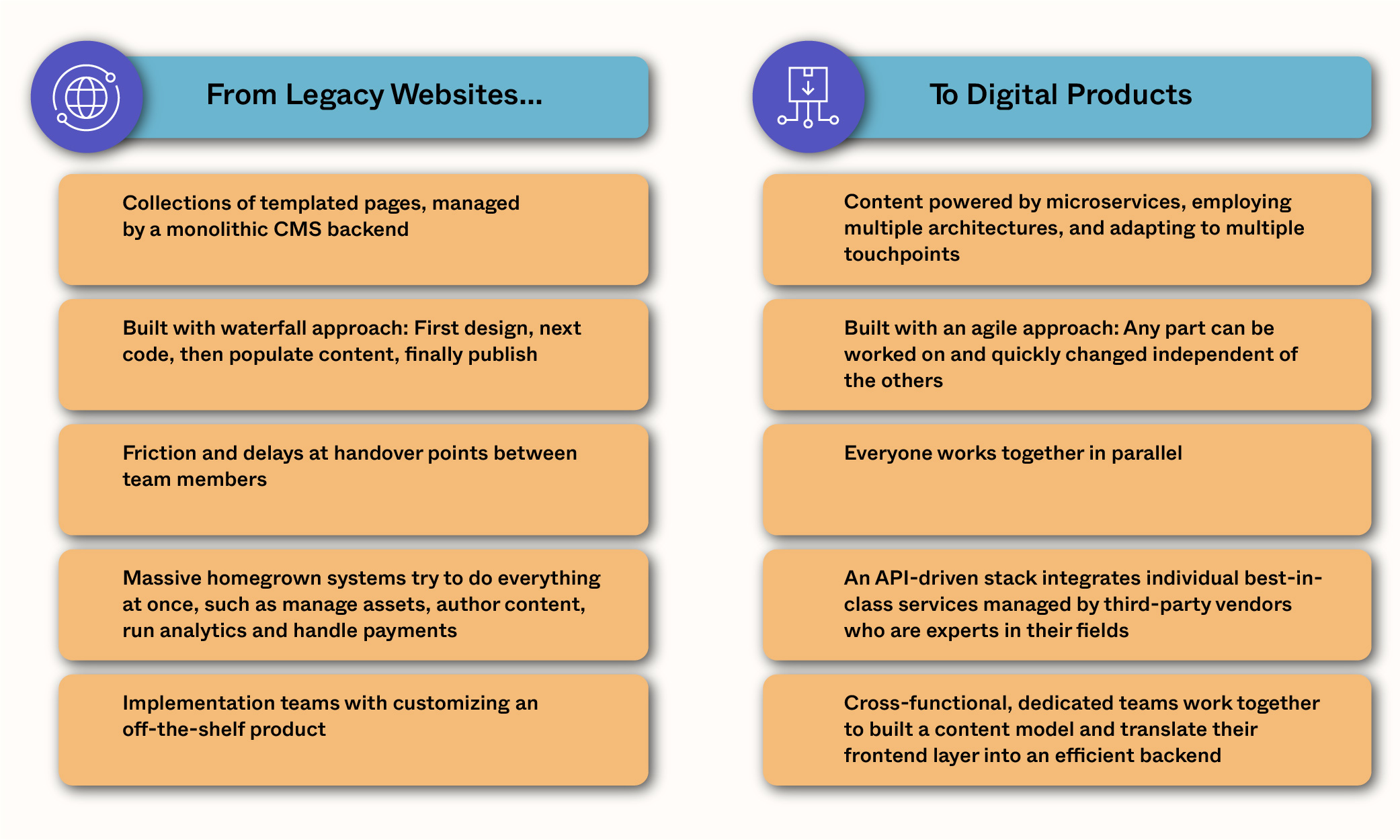
If you’re still wondering why you should overhaul your career site even though it’s meeting your current needs, consider the following:
- End users expect a regular cadence of fresh content; this keeps them engaged and encourages them to return – again and again and again. And again.
- Developers’ talents are better used building software, without the distraction of hardcoding content.
- Client content creators and editors want self-service control over their narratives, with a simple system to input and push content live in real-time.
Content Management as a Service
As we’ve now established, there’s a gap in the market between what organizations need, candidates expect, and the current state of career sites. Let’s draw a parallel: in the world of marketing, we’ve seen the emergence of headless CMS that gives users the ability to manage content in one place and still deploy that content across any presentation layer they choose. In short, it’s a low-code alternative to a traditional CMS. Headless CMS has become popular because it allows users to quickly repurpose content and deploy it at scale. Traditionally, CMS clubbed everything into one big bucket – images, HTML, content, CSS, etc., which made it impossible to reuse content because it was intermingled with code.
In the HR tech world, however, we are yet to come across a seamless API-driven model that makes content infinitely reusable. A big part of the problem is how the vendor ecosystem views career sites. It’s typically an afterthought to ATS and HCM (Human Capital Management), designed more as a tactical data-gathering data tool rather than a platform that empowers users to do more with their content.
The solution is designing career sites as managed content services, where the team can deliver an end-user experience via API. Users can easily take control of these sites for better UI and cost-effectiveness.
Here are a few features and capabilities that career sites as content management services will offer:
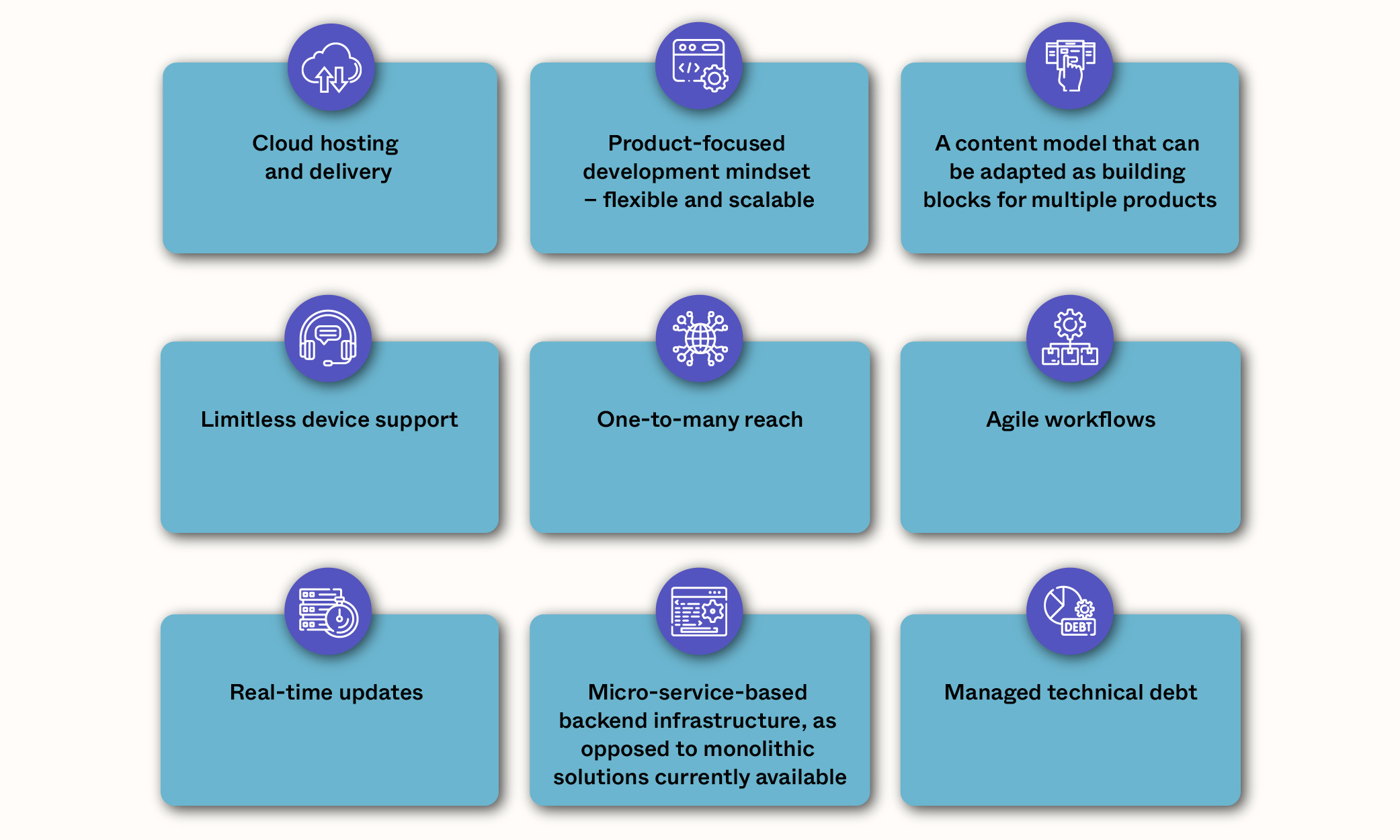
In addition to better technical architecture (woo-hoo!), envisioning career sites as a managed content service also offers several end-user benefits, including:
- Multi-language support: Easily manage and distribute content on a single website in multiple languages. This means increased geographic reach, while eliminating the need for multiple sites.
- Hub pages: Consolidate all content across showcase pages in one location, filtered by topics, categories, or locations for a terrific candidate experience.
- Customized content: Use customized page and section templates as building blocks. Add various job lists, job alert modules, data capture forms, recruiter contact info, and more.
- Efficient solutions: Quickly copy successful pages to edit and repurpose for new campaigns. Use dynamic content to edit the site and tie relevant jobs to new pages.
- Smart analytics: Adapt content strategies by measuring page activity and reviewing analytics from the overall site in a centralized dashboard.
- Brand identity protection: Maintain brand integrity and streamline team workflows with two user levels: editors create pages, and publishers edit pages to ensure content is on-brand.
So, teams can quickly adapt to writing articles, promoting events, sharing timely content, and connecting with candidates like never before. Career sites as a managed content service is a valid extension of the recruitment strategy, bringing branded assets and optimized content to life! This also means that recruitment teams have more control to create and edit pages exactly when needed and “go live” in minutes. Shazam!
Buy vs Build
When it comes to creating a career site, companies are often on the fence about a crucial decision – should they build it in-house or outsource development? Both options have their pros and cons. Here’s a closer look at each approach to help you make an informed decision.
Building an in-house career site
Benefits
- Customization: Tailor every aspect of your site to fit your brand and specific needs
- Control: Maintain complete control over the design, functionality, and content updates
- Integration: Seamlessly integrate with existing systems and software, ensuring a cohesive experience for both recruiters and candidates
Challenges
- Resource-intensive: Requires a significant amount of time, money, and skilled labor
- Maintenance: Needs regular updates and fixes, which means time and resources
- Speed to market: An in-house site can take longer, delaying the benefits of a well-designed career site
Outsourcing a career site
Benefits
- Expertise: Leverage the experience and skills of pros who specialize in career site development
- Speed: Get your site up and running faster with a dedicated project team
- Cost-effective: Avoid the expenses associated with hiring and training an in-house team and maintaining the site
Challenges
- Limited control: It’s difficult to make on-the-fly changes and customizations
- Dependence on vendors: External providers are required to make updates and troubleshoot
- Integration issues: Potential challenges in integrating the outsourced site with your existing systems
Comparison Table
| Factor | Build in-house | Outsource |
| Customization | High, can be tailored to exact needs | Moderate, depends on vendor capabilities |
| Control | Full control over all aspects | Limited, depends on vendor |
| Expertise required | High, requires skilled employees | None, provided by vendor |
| Speed to market | Slower due to development time | Faster with a dedicated team |
| Cost | High, upfront and ongoing maintenance | Variable, usually lower upfront |
| Maintenance | Continuous, handled internally | Handled by vendor, may incur extra costs |
| Integration | Seamless with existing systems | Potential challenges, depends on vendor |
Choosing between building an in-house career site and outsourcing it’s development depends on your org’s unique needs. If you have the internal expertise and resources, building in-house offers unparalleled control and customization. However, outsourcing can be a cost-effective and efficient solution, especially if hiring is not your core business. Ultimately, the right choice will need to align with your strategic goals and operational capabilities.
Seven Tips for a Successful Career Site, Offering Stellar Candidate Experience
1. Create a user-friendly career site
Navigating your career site should be a breeze. It’s important for job seekers to easily find job listings, company information, and the application portal – that’s the intent of having a career site. A clean, intuitive design helps candidates focus on what matters most and helps them discover suitable opportunities with your company.
2. Utilize multimedia effectively
Bring your career site to life with videos, photos, and infographics. Showcasing employee testimonials, office tours, and company events helps candidates get a real feel of your workplace culture. A dynamic multimedia approach can make your company stand out and feel more approachable.
3. Don’t forget to be creative
Your career site doesn’t have to be a soulless corporate page. Add creative elements that reflect your brand’s personality and values. Experiment with vibrant graphics, interactive elements, or maybe a fun facts section about your team – creativity can leave a lasting impression. Canva’s career site is a great place to get inspired.
4. Simplify the application process
A lengthy, complicated app process can deter even the most enthusiastic of candidates. We bet you’ve jumped ship on at least one application because of the amount of unnecessary info it demanded. That’s why it’s important to streamline your application forms and allow applicants to upload resumes directly from their LinkedIn profiles. Make the process as quick and painless as possible to encourage more submissions and made for all kinds of devices.
5. Highlight your benefits and perks
Candidates want to know what’s in it for them. Make sure to prominently display the benefits and perks your company offers. From basics like health insurance and retirement plans to remote work options and wellness programs, highlight what makes working at your company rewarding.
6. Showcase your company’s diversity
Diversity and inclusion are top priorities for many job seekers in 2024. Use your career site to demonstrate your commitment to building a diverse and inclusive workplace. Highlight initiatives, employee resource groups, and even diversity statistics to show that you value and support all employees.
7. Feature your employer awards
If you’ve received awards or recognition, this is the place to flaunt them! Employer awards signal to candidates that your company is a great place to work. Displaying these accolades on your career site can boost your credibility and attractiveness as an employer. Yippie!
Common Mistakes to Avoid While Building a Career Site
Hard-to-find career site
If your career site is hidden, candidates won’t find it and they’ll move right on. Make sure your career site is easily accessible from your homepage and all relevant sections of your website. Think of it like a storefront window – if it’s not visible, you’re missing out on potential customers. Net-net: Make the career site link prominent on your homepage and easily navigable from other parts of your website.
Outdated information on your career site
Nothing turns off candidates faster than finding outdated job postings and company info. Keep your career site fresh with the latest jobs, company news, social feeds, and employee testimonials. How would you feel walking into a store and seeing outdated items and incorrect pricing? Would you be confident buying anything? NOPE! And neither would job seekers. So, regularly update your job listings and ensure all information reflects your current company status and culture.
Not showcasing your company culture
Your career site should be a window into your workplace culture. Use photos, videos, employee stories, and other multimedia to give candidates a glimpse of what it’s like to work with you. If you offer fun team-building activities, show them! Candidates want to see more than just job descriptions – they want to know if they’ll fit in (and so do you). Highlighting your unique company culture can be the deciding factor when great-fit talent is choosing between you and the competition.
Poor search functionality
Poor search functionality can also be a real put off for candidates. Your job search feature should be user-friendly and efficient, allowing candidates to filter and find relevant positions quickly. Think of it like a catalog system, something that makes the job hunt easy and organized, eliminating the chaos! Include filters for job type, location, and department to help candidates zero in on the role that’s perfect for them.
Neglecting SEO
SEO isn’t just for blogs and other marketing pages; it’s crucial for career sites, too. Optimize your job postings with relevant keywords to ensure they show up in search engine results. If candidates can’t find your job listings through a quick Google search, you’re missing out BIG TIME. Use specific job titles, industry terms, and phrases that candidates are likely to search for to improve your visibility.
Four Best Career Site Examples
Inergroup

Inergroup Insourcing Solutions helps companies save money and improve efficiency by bringing the benefits of outsourcing in-house. They focus on using the best methods and custom strategies to meet their clients’ needs. Inergroup works with well-known brands to provide flexible and cost-effective staffing solutions.
What makes their career site fab?
Well, Inergroup’s career site features the latest job openings upfront, making it easy for candidates to see what’s available. Jobs are divided into specific categories, allowing for quick and easy navigation. Plus, the site offers a talent community where candidates can connect and stay updated on future opportunities.
Canadian Tire

Canadian Tire is a Canadian retail company which operates in the automotive, hardware, sports, leisure, and housewares sectors.
What makes this career site stand out?
Canadian Tire’s career site offers a comprehensive view of job opportunities across its group of companies. It provides a peek into their social media presence, keeping candidates connected and informed. The latest job openings are prominently displayed, making it easy for candidates to find and apply for new positions. The site also features a talent community, allowing candidates to stay updated on future opportunities.
Mindfield

Mindfield revolutionizes recruitment with cost-effective, time-efficient solutions tailored to industries like manufacturing, retail, hospitality, and healthcare. Offering talent acquisition, recruitment strategy, employer branding, and enhanced candidate experiences, they utilize cutting-edge digital marketing and HR technology to streamline sourcing, screening, and placement.
And how does this career site stand out?
Mindfield’s career site exemplifies efficiency with its clear communication, simple and intuitive UX, and easy-to-find job listings. It streamlines the candidate journey, ensuring job seekers can quickly and effortlessly navigate through opportunities and apply with confidence.
Joveo

In case you haven’t had the chance to get to know us, Joveo is a performance-driven, AI-powered recruitment marketing platform. Our goal is to enable organizations to attract, source, and engage great candidates on time, while reducing costs and providing real-time insights at every step of the job seeker journey.
Joveo’s career site is a true reflection of our vibrant work culture. The use of casual, conversational language throughout the site makes candidates feel welcome and comfortable, encouraging them to advance in the application process. Our site features concise, transparent team descriptions, showcasing our commitment to openness and a high regard for our employees. The messaging across the career site consistently emphasizes the value Joveo places on its people, making it clear that they are at the heart of the company’s success.
Conclusion
Your career site isn’t just about listing job openings anymore — it’s a dynamic platform that shapes candidates’ perceptions of your organization. By leveraging structured content models and managed content platforms, you can create tailored, engaging experiences that showcase your unique company culture and meet your recruitment needs.
Career sites designed well by integrating the right tools can be scaled effortlessly for multi-channel experiences, whether it’s localized sites for multinational organizations or responsive mobile apps. This ensures an intuitive journey for candidates, reducing drop-off rates and improving hiring success.
In essence, your career site becomes a strategic asset, reflecting your commitment to attracting and retaining top talent while driving organizational success. By focusing on user-centric design and continuous optimization, you ensure your career site remains a vibrant platform for future candidates and a testament to your employer brand.
Ready to take your career page to the next level? Let us show you what we can do! And don’t forget to follow us on X and LinkedIn.
FAQs
What is a career site?
A career site is a dedicated section of a company’s website where job seekers can find information about open positions, company culture, and the application process. It serves as a central hub for all things related to employment opportunities within the organization.
Why are career sites important?
Career sites are essential for attracting top talent, showcasing the company’s employer brand, and providing a seamless application experience for candidates. They help companies stand out in a competitive job market and attract candidates who are the right fit for the organization.
How can I create an effective career site?
To create an effective career site, focus on clear and concise job descriptions, engaging content that highlights your company culture and values, easy navigation, and mobile optimization. Make sure the application process is straightforward and provides a positive experience for candidates.
What features should a good career site have?
A good career site should have a user-friendly interface with easy navigation, a search function for job listings, detailed job descriptions, information about company culture and values, employee testimonials, and a seamless application process.
How can I drive traffic to my career site?
You can drive traffic to your career site by optimizing it for search engines (SEO), promoting it on social media channels, participating in job fairs and industry events, and engaging with potential candidates through targeted recruitment campaigns.
What role does a career site play in employer branding?
A career site is a crucial component of employer branding as it helps companies communicate their values, culture, and opportunities to potential candidates. It showcases what makes the company unique and attractive as an employer, helping to attract and retain top talent.
Looking to streamline your recruitment efforts?
- Try our Job Description Optimizer for quick, effective job descriptions.
- Forecast your ad spend with the CPA Calculator.
- Need help choosing vendors? Explore our RFP Templates for expert guidance.
Also read:
